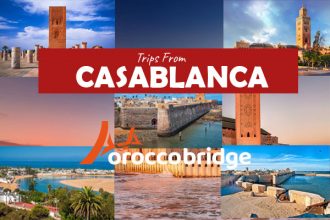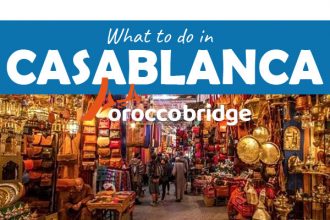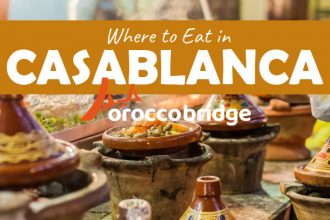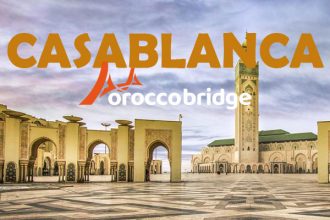Casablanca
Explore Morocco’s largest city — a vibrant blend of tradition and modernity, culture and commerce, Atlantic breezes and Art Deco streets.
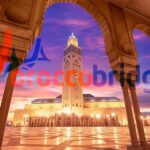
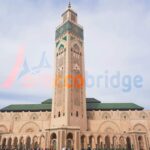



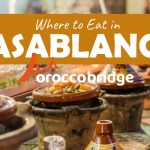
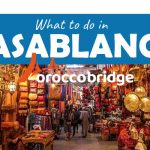

Last Updates
When to Visit Casablanca
- Spring (Mar–May): Pleasant weather, perfect for city walks.
- Summer (Jun–Aug): Warm and lively — ideal for beach days at Ain Diab.
- Autumn (Sep–Nov): Mild temperatures and fewer crowds.
How to Get to Casablanca
- By Air: Direct flights to Mohammed V Airport from major cities.
- By Train: ONCF trains connect Casablanca to Rabat, Marrakech, and Tangier.
- By Bus: CTM and Supratours operate routes nationwide.
- By Car: Connected via A3 and A1 highways.
Where to Stay in Casablanca
- Luxury Hotels: Four Seasons, Hyatt Regency, Sofitel Tour Blanche.
- Mid-range: Kenzi Tower, Barcelo Anfa.
- Budget: Hotel Central, MELLIBER Appart Hotel.
- By the Sea: Hotels on Ain Diab Corniche.
What to Do in Casablanca
Top Attractions
- Hassan II Mosque
- Old Medina
- Mohammed V Square
- The Corniche (Ain Diab)
- Habous Quarter (New Medina)
- Arab League Park
Museums & Culture
- Villa des Arts
- Museum of Moroccan Judaism
- Art Deco walking tours
Food & Dining
- Sample seafood at La Sqala or Rick’s Café
- Try street foods: “briouat,” “maakouda,” “harcha”
- Explore cafés on the Corniche
Activities
- Walk along Ain Diab beach
- Surfing lessons
- Shopping at Morocco Mall or AnfaPlace
- Nightlife and rooftop bars
Where to Eat & Drink
- Traditional Moroccan: La Sqala, Dar Beida
- International Cuisine: Le Cabestan, Iloli (Japanese), Blend Gourmet Burger
- Cafés & Rooftops: Sky 28, Café Bianca
- Nightlife: Le Kimmy’z, Le Gatsby
Where to Shop
- Traditional Markets: Habous Souk for leather, spices, and handicrafts.
- Modern Malls: Morocco Mall, AnfaPlace.
- Souvenirs: Argan oil, ceramics, Moroccan lamps, rugs.
Getting Around Casablanca
- Taxis: Red taxis (city) and white taxis (intercity).
- Tramway: Clean, safe, and convenient for major areas.
- Car Rentals: Available at the airport and downtown.
- Public Buses: Operated by Alsa – budget-friendly.
Day Trips from Casablanca
- El Jadida: Portuguese City and beaches (1h drive).
- Rabat: The capital’s Kasbah and Medina (1h by train).
- Azemmour: Art town and scenic river views (1.5h drive).
- Settat: Countryside experience (1h away).
Safety & Travel Tips
Keep valuables secure in crowded areas.
Dress modestly, especially in religious sites.
ATMs are available; credit cards accepted in most hotels/restaurants.
Tipping is appreciated (5–10%).
French and Arabic are useful; English works in tourist zones.
Map & Directions
Getting to Casablanca
Casablanca (Arabic: الدار البيضاء – Dar al-Bayda) is located on Morocco’s Atlantic coast, about 90 km (56 miles) southwest of Rabat, the capital city. It’s the largest city in Morocco and the country’s main economic hub.
✈️ By Air:
- Mohammed V International Airport (CMN) is about 30 km south of the city center.
- It’s the main gateway for international travelers.
- From the airport:
- 🚆 Train: 45–50 min to Casa Voyageurs Station.
- 🚖 Taxi: 30–40 min depending on traffic.
By Train:
- Casablanca is well-connected via the ONCF rail network.
- Major train stations:
Casa Voyageurs (main hub)
Casa Port (near downtown and the Corniche)
High-speed Al Boraq trains connect Casablanca with Tangier in just 2 hours.
By Bus:
- Long-distance buses (CTM, Supratours) arrive at Oulad Ziane Bus Station.
- Buses connect Casablanca with Marrakech, Rabat, Fez, Agadir, and other cities.
By Car:
- Casablanca is linked by modern highways:
- From Rabat: via A3 (1 hour)
- From Marrakech: via A7 (2.5 hours)
- From El Jadida: via A5 (1 hour 15 minutes)
Casablanca FAQ
Yes, Casablanca is generally safe for tourists. Major areas like the Corniche, Hassan II Mosque, and downtown are well-patrolled. However, like any big city, avoid poorly lit streets at night and keep an eye on personal belongings in crowded areas.
Yes, non-Muslims can visit the Hassan II Mosque through guided tours. The mosque is one of the few in Morocco open to non-Muslims. Tours are available in multiple languages, including English and French.
You have several options:
Train: Direct service from Mohammed V Airport to Casa Voyageurs (~45–50 min).
Taxi: Red taxis (fixed rates) or private transfers (~30–40 min).
Car Rental: Available at the airport.
Spring (Mar–May) and Autumn (Sep–Nov) are ideal for sightseeing and beach activities.
Summer (Jun–Aug) is warm, lively, and perfect for Corniche activities.
Winter (Dec–Feb) is mild but rainy, less crowded.
Arabic (Darija) is the main language.
French is widely used for business and tourism.
English is spoken in tourist areas, hotels, and restaurants.
It depends on your nationality:
Citizens from the EU, USA, Canada, and many countries can enter Morocco visa-free for up to 90 days.
Others must apply for a tourist visa at a Moroccan consulate before traveling. Always check the latest requirements.
The Moroccan Dirham (MAD) is the local currency. ATMs are widespread, and major hotels and restaurants accept credit cards.
Tramway: Efficient, modern, and covers major areas.
Taxis: Red taxis for the city, white taxis for intercity travel.
Buses: Operated by Alsa – affordable but slower.
Car Rentals: Available for flexible travel, especially for day trips.
Traditional Souks: Habous Quarter for handicrafts, leather, and spices.
Modern Malls: Morocco Mall, AnfaPlace for fashion, electronics, and dining.
Traditional Moroccan dishes: tagine, couscous, bastilla, briouat
Seafood: Fresh fish along Ain Diab Corniche
Sweet treats: Chebakia, M’hanncha, Halwa
Yes! Popular day trips include:
Rabat: Morocco’s capital, 1 hour by train.
El Jadida: Portuguese city and beaches, 1 hour drive.
Azemmour: Historic riverside town, 1.5 hours drive.
Yes, tipping is customary:
Restaurants: 5–10% of the bill
Taxis: Round up the fare or tip a few dirhams
Hotels: Bellhops and housekeeping: 10–20 MAD
Yes, most hotels, restaurants, and shopping malls accept Visa and Mastercard, but cash is preferred in souks and small shops.
Dress comfortably, but modest clothing is recommended in religious and traditional areas.
Beachwear is fine at Ain Diab Corniche.
Yes, Wi-Fi is widely available in hotels, cafés, and some public areas. For reliable access, consider a local SIM card with data.
Yes, Casablanca has well-equipped hospitals and pharmacies. Major hospitals include:
Cheikh Khalifa International Hospital
Centre Hospitalier Universitaire Ibn Rochd
Pharmacies are open during the day, with some on 24-hour rotation.


